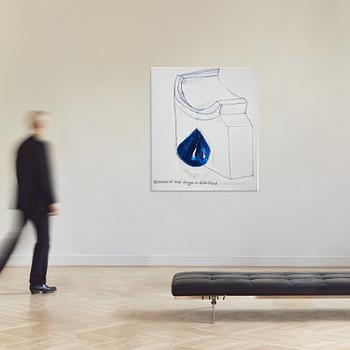Torsten Andersson
'Monument med droppe av blått blod. Den kreativa människans blod'
Signed Torsten verso. Executed in 2006. Canvas 151 x 130 cm.
Alkuperä - Provenienssi
Brändström & Stene, Stockholm.
Private Collection, Stockholm.
Näyttelyt
Moderna Museet, Stockholm, 'Modernautställningen', 18 February - 7 May 2006.
Brändström & Stene, Stockholm, 'Torsten Andersson', 24 November 2006 - 7 January 2007 .
Muut tiedot
Susanna Slöör, art critic and writer, wrote about the exhibition at Brändström & Stene in 2006/2007:
"Torsten Andersson's (born 1926) peculiar object painting has deliberately navigated between the suffocating demands imposed on art in general and painting in particular. In connection with his return in the mid-1980s after twenty years of silence, he spoke about the importance of formulating a 'third way' between exhausted modernism and self-negating postmodernism. The portraits of fictional sculptures that he has presented since then take shape as distinctive containers. Symbolically, one can see them as metaphors for the unfathomable content of language, humanity, and art. 'The sculpture is bleeding,' Andersson adds as an encouraging guide to his exceptionally elusive world. The formats are large, the drawing is powerful and simply executed directly on the carelessly stretched canvases. The colors, in turn, are few and fiercely juxtaposed in their unprocessed state. Here at the exhibition, red clashes with blue in a symbolically charged encounter between the red plank and the blue drops of blood.
Through snippets of text on the canvas, we learn that a plank in a Carl Larsson painting is the starting point for several of the latest paintings on display at Brändström & Stene. The 'Falun red' backyard is colored blue by a blood-colored shadow. It is the true color of the 'creative person's blood', of which a drop is worth a monument in itself, according to another painting. The creative person's torment is then revealed as the blood is filtered through a blood vessel equipped with a knife 'like in a Swedish meat grinder'. One can assume that the exaggerated rhetoric should not be interpreted too literally and therefore does not imply that the artist is particularly noble or more thin-skinned than anyone else, but rather that the symbolism is more of a nonsensical nature. The signs simply fit well into the form."




















































